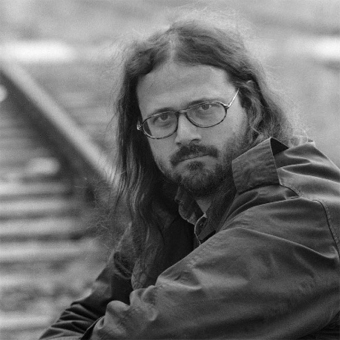
Steffen Schleiermacher
Giving a Form to Individuality
by Detlef Lehmbruck
Varied though its external surface may appear, Steffen Schleiermacher's music is distinguished by the fact that it dispenses completely with ornamental arabesques and "sexless games with notes" (Schleiermacher). For a composer who was born in Halle, East Germany, in 1960 and reached maturity in the eighties during the disintegrating German Democratic Republic (GDR), this is hardly surprising.Like many of his contemporaries, Schleiermacher wanted to distance himself from the late-Expressionist outbursts which were characteristic of the middle generation of GDR composers. Thus from the beginning his work was ruled by the desire for transparency in its musical processes. For example, the early Gesang des Apsyrtos (1985) which employs the instrumentation of Stockhausen's Kreuzspiel, exhibits distinctive features: a structure of movements, oriented around the various groups of instruments, that marks each layer with specific gestures and functions within the context of the work as a whole. Schleiermacher's compositional interest here, as in the majority of his works, is directed more toward problems concerning the organisation of rhythm and meter, toward the dialectic of ostinato rhythmic sections and complex superimpositions, and less toward the organisation of pitch, which here is rooted in Messiaen-like modes. The same can be said of Festgefressen (1994), Schleiermacher's only string quartet to date.Although there are structural similarities between the individual works, their sources of inspiration are very different: Gesang des Apsyrtos, Kreon (1987) for chamber orchestra, and Sisyphos (1996) for brass instruments and drums, are inspired by Greek mythology whereas the inspiration for Festgefressen and Trio for trombone, cello and piano (1987) lies in the idea of a communicative or social situation: The rather unusual title (of Festgefressen) describes a state of hopelessness, against which, however, one does not cease to fight. A movement is forced to slow down and in its one-sidedness, is ultimately doomed to standstill. In the string quartet, this standstill-state is produced through harmony, melody, and rhythm - there is no harmonic development. Rigid eight-note chords provide the foundation for the musical events; short melodic and rhythmic clichés occasionally attempt a development but they always run aground, getting stuck in certain models and continually turning in upon themselves. (Schleiermacher)
Yet Gesang des Apsyrtos also demonstrates that Schleiermacher's interest is aroused by the structural situation of this Greek myth about Medea's stratagems: the figures of the song that revolve around and within themselves in the two high woodwind instruments are a musical image of those who are the prisoners of rituals, the ones without hope. However, to rank Schleiermacher among the so-called "committed" composers on the basis of this would be inappropriate. To convey political and ideological messages through music is as foreign to him as the attempt by the serialists to formulate an aesthetic program through the perfect legitimisation of a composition. Like most of the composers of his generation, Schleiermacher's music is based on the desire to delineate a position that stresses the individuality of each work and its character and thus, ultimately, that of the individual human being: a desire that is informed in no small measure by a deep distrust of all forms of collective ideology, in music as well as elsewhere.Moreover, with a musician such as Schleiermacher who sees the role of the performer of the work as being on equal footing with its composer, the aspect of music-making plays a role in all his works. This aspect is also found, for example, in the œuvre of Vinko Globokar or Luciano Berio: the human situation portrayed within a piece of music in a more or less abstract way thus corresponds to the musical role of the musician who performs it. It is tailored to fit the musician like a glove, so to speak. So it is not surprising that some of Schleiermacher's works take on theatrical traits in performance, insofar as they are not already rather close to certain trends in musical drama, like the dramatic chamber music of Sei auf dem (?) Hut (1985) or Zeremonie for chamber ensemble (1988). In turn, his understanding of the interpretation of music as role-play initiates the structuring of musical composition in layers, as described above. This is inherent for those works which take musical structure as their direct starting point as, for example, Quintett for violin, cello, flute, clarinet and piano (1989) where the individual sections are each confined to one interval group or Musik for chamber ensemble (1990), which is an attempt to translate the ideas of Kandinsky's text "Dots and Lines on the Surface" into music. It begins with hard and short unisono chords on the piano and xylophone which are gradually projected into time through the sustained notes of the wind section, as a result of which dots become lines. The uncompromising harshness of its gestures places this music in the tradition of Stravinsky, Varèse and Xenakis.
© by Detlef Lehmbruck
translation: Gloria Custance
